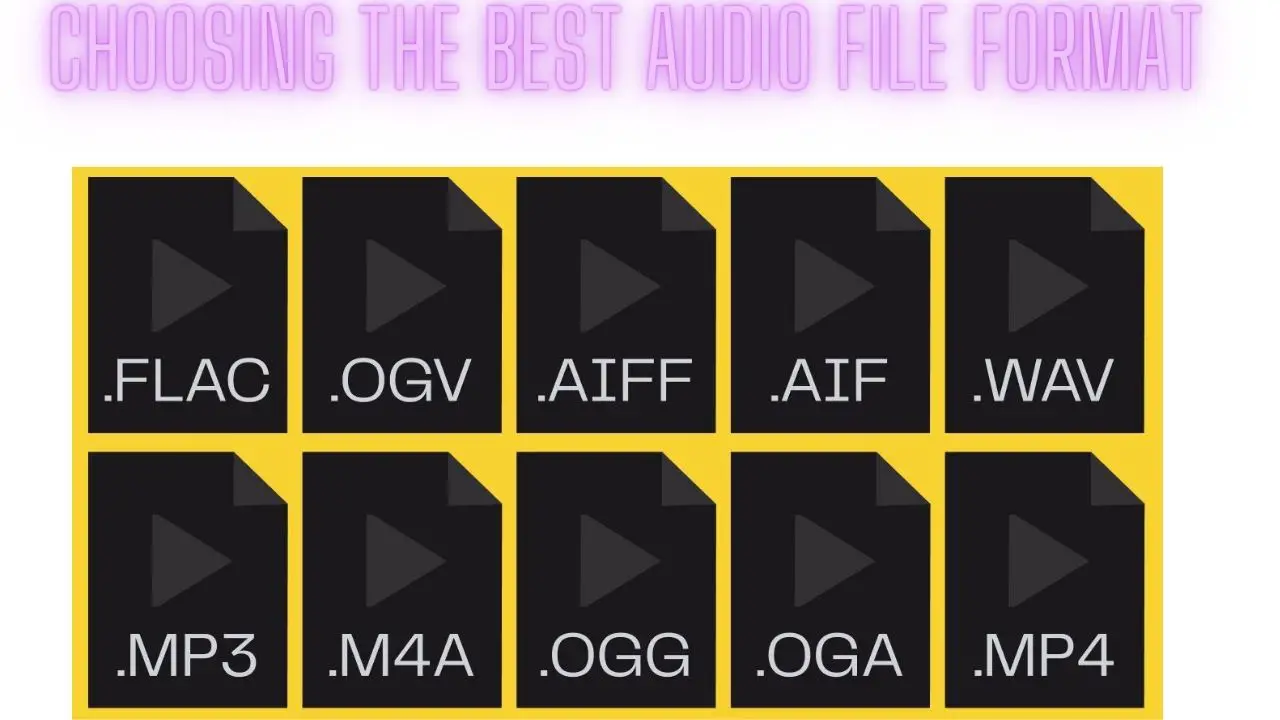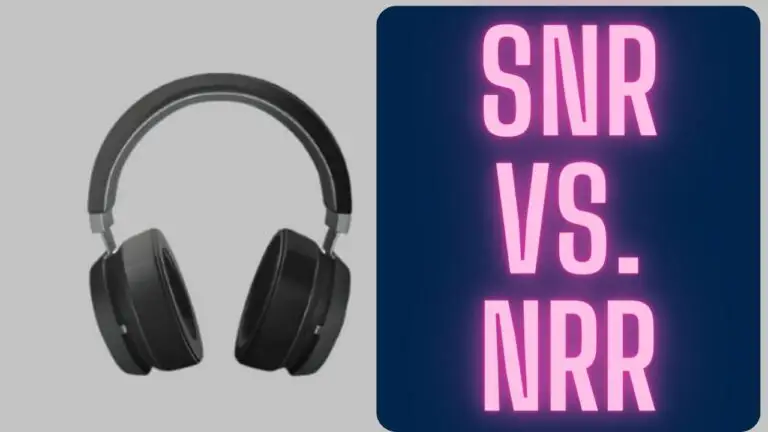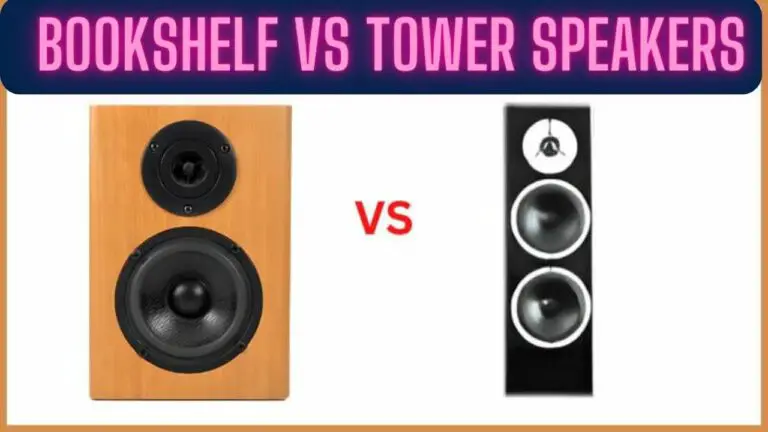Choosing the Best Audio File Format
Introduction
Choosing the best audio file format is crucial for ensuring optimal sound quality, compatibility, and efficiency in various audio applications. With many audio formats available, each with unique features and benefits, selecting the right format can significantly impact the listening experience and workflow for consumers and professionals. This guide provides an overview of different audio file formats, factors to consider when choosing between them, and guidance on selecting the most suitable format for your specific needs. Whether you’re an audiophile, musician, content creator, or simply someone who enjoys listening to music, understanding the nuances of audio file formats can enhance your appreciation and enjoyment of sound.
Understanding Audio File Formats
Audio file formats determine how digital audio data is stored and encoded. Each format has its own characteristics, including compression methods, sound quality, and compatibility with different devices and software. Here’s a brief overview of some common audio file formats:
- MP3 (MPEG-1 Audio Layer III):
- One of the most widely used audio formats for digital music.
- Uses lossy compression to reduce file size while maintaining reasonable sound quality.
- Compatible with nearly all devices and media players, making it convenient for sharing and distributing music.
- AAC (Advanced Audio Coding):
- Developed as the successor to MP3, offering better sound quality at lower bitrates.
- Commonly used for streaming music and digital downloads, particularly in the iTunes Store and other online music platforms.
- Provides more efficient compression than MP3, resulting in smaller file sizes without significant loss of quality.
- WAV (Waveform Audio File Format):
- An uncompressed audio format that retains the original, uncompressed audio data.
- Offers high-quality audio reproduction but results in larger file sizes compared to compressed formats like MP3 and AAC.
- Widely supported across various audio editing software and professional audio production applications.
- FLAC (Free Lossless Audio Codec):
- A lossless audio format that compresses audio data without sacrificing quality.
- Ideal for audiophiles and music enthusiasts who prioritize sound fidelity and want to preserve the original audio quality.
- Supports metadata and allows for tagging and album artwork, making it suitable for organizing music libraries.
- ALAC (Apple Lossless Audio Codec):
- Apple’s proprietary lossless audio format, similar to FLAC but developed specifically for Apple devices and software.
- Offers high-quality audio compression while retaining compatibility with iTunes, iOS devices, and other Apple products.
- Suitable for users within the Apple ecosystem who want to maintain lossless audio quality.
- OGG Vorbis:
- A free, open-source audio format that offers high-quality compression.
- Commonly used for streaming audio on the web and in gaming applications.
- Provides better sound quality than MP3 at similar bitrates and file sizes.
- AIFF (Audio Interchange File Format):
- Similar to WAV, AIFF is an uncompressed audio format commonly used in professional audio production and recording.
- Developed by Apple but widely supported across both macOS and Windows platforms.
- Offers high-quality audio reproduction and is compatible with various audio editing and production software.
- M4A (MPEG-4 Audio):
- Container format used to store audio data encoded with AAC or ALAC codecs.
- Commonly used for music downloads and streaming on Apple devices.
- Supports metadata and allows for tagging and album artwork.
Understanding these audio file formats is essential for choosing the best format for your specific needs, whether it’s for listening to music, editing audio recordings, or distributing content online. Each format has its advantages and disadvantages, so it’s essential to consider factors such as sound quality, file size, compatibility, and intended use when selecting the most suitable format.
Factors to Consider When Choosing an Audio File Format
- Sound Quality: Consider the level of audio fidelity you require. Lossless formats like WAV, FLAC, and ALAC preserve the original audio quality without any loss of data, making them ideal for audiophiles and professional audio production. Lossy formats like MP3 and AAC sacrifice some audio quality for smaller file sizes, suitable for casual listening and online streaming.
- Compression: Evaluate the compression method used by the audio format. Lossless formats maintain the original audio data without any loss of quality but result in larger file sizes. Lossy formats employ compression algorithms to reduce file size but may compromise sound quality to varying degrees.
- File Size: Determine the importance of file size in your use case. Lossy formats offer smaller file sizes, making them convenient for storing and streaming music on portable devices and over the internet. Lossless formats result in larger file sizes but provide higher audio quality and are preferable for archival purposes or critical listening.
- Compatibility: Check the compatibility of the audio format with your playback devices, software applications, and operating systems. Some formats are more widely supported across various platforms, while others may be proprietary or less commonly used. Consider the devices and software you regularly use to ensure compatibility with your chosen format.
- Metadata Support: Consider whether the audio format supports embedded metadata, such as track information, album art, and tags. Metadata allows for better organization and management of your music library, particularly when using media players and library management software.
- Intended Use: Determine the primary purpose of the audio files and how they will be used. For example, if you’re creating music for distribution online or for streaming platforms, you may prioritize compatibility and file size over absolute audio quality. Conversely, if you’re mastering audio recordings or producing high-fidelity music, you may prioritize sound quality and opt for a lossless format.
- Streaming and Online Distribution: If you intend to distribute your music online or stream it over the internet, consider the compatibility of the audio format with streaming platforms and online services. Some formats may be better optimized for online streaming, offering a balance between sound quality and file size.
- Editing and Production: If you’re working with audio editing and production software, consider the compatibility of the format with your editing workflow. Certain formats may be more suitable for editing and processing, while others may require conversion or transcoding before editing.
By considering these factors, you can make an informed decision when choosing the best audio file format for your specific needs and preferences. Whether you prioritize sound quality, file size, compatibility, or metadata support, selecting the right format ensures an optimal listening experience and workflow efficiency.
Comparison of Popular Formats
- MP3 (MPEG-1 Audio Layer III):
- Compression: Lossy
- Sound Quality: Reasonable, but some loss of audio data
- File Size: Relatively small
- Compatibility: Widely supported across devices and media players
- Use Case: Ideal for casual listening, sharing, and distribution of digital music
- AAC (Advanced Audio Coding):
- Compression: Lossy
- Sound Quality: Better than MP3 at similar bitrates
- File Size: Smaller than MP3 for equivalent sound quality
- Compatibility: Commonly used for online music streaming, iTunes Store, and Apple devices
- Use Case: Suitable for digital downloads, streaming, and distribution on Apple platforms
- WAV (Waveform Audio File Format):
- Compression: Uncompressed (lossless)
- Sound Quality: High, retains original audio data
- File Size: Larger than compressed formats like MP3 and AAC
- Compatibility: Supported by most audio editing software and professional applications
- Use Case: Ideal for audio production, editing, and archival purposes where sound fidelity is paramount
- FLAC (Free Lossless Audio Codec):
- Compression: Lossless
- Sound Quality: High, preserves original audio quality without compression artifacts
- File Size: Smaller than WAV but larger than MP3 and AAC
- Compatibility: Supported by many media players, streaming platforms, and audio software
- Use Case: Preferred by audiophiles and music enthusiasts for its high-quality sound reproduction and archival purposes
- ALAC (Apple Lossless Audio Codec):
- Compression: Lossless
- Sound Quality: Comparable to FLAC, preserves original audio quality
- File Size: Similar to FLAC, slightly larger than AAC
- Compatibility: Designed for Apple devices and software, compatible with iTunes and iOS devices
- Use Case: Suitable for users within the Apple ecosystem who want lossless audio quality and compatibility with iTunes
- OGG Vorbis:
- Compression: Lossy
- Sound Quality: Better than MP3 at similar bitrates
- File Size: Comparable to MP3 for similar sound quality
- Compatibility: Supported by various media players, web browsers, and gaming platforms
- Use Case: Commonly used for online streaming, gaming audio, and open-source projects
- AIFF (Audio Interchange File Format):
- Compression: Uncompressed (lossless)
- Sound Quality: High, retains original audio data
- File Size: Similar to WAV, larger than compressed formats
- Compatibility: Widely supported on both macOS and Windows platforms
- Use Case: Preferred by audio professionals for recording, editing, and mastering audio projects
This comparison highlights the key differences between popular audio formats, including their compression methods, sound quality, file sizes, compatibility, and use cases. Depending on your specific needs and preferences, you can choose the format that best suits your requirements for sound quality, file size, and compatibility with your devices and software.
Compatibility Considerations
When choosing an audio file format, it’s essential to consider compatibility with various devices, media players, and software applications. Here are some key compatibility considerations to keep in mind:
- Playback Devices: Ensure that the audio format you choose is compatible with the devices you intend to use for playback. Most modern smartphones, tablets, computers, and dedicated media players support popular audio formats like MP3, AAC, and WAV. However, less common or proprietary formats may not be supported by all devices.
- Operating Systems: Check compatibility with the operating systems used on your devices. Popular audio formats are generally supported across multiple operating systems, including Windows, macOS, iOS, and Android. However, some formats may have limited support on certain platforms or require additional software for playback.
- Media Players: Consider the media player software you use for listening to music or managing your audio library. Most media players, such as VLC, iTunes, Windows Media Player, and Foobar2000, support a wide range of audio formats. However, specialized or less common formats may require third-party plugins or codecs for playback.
- Streaming Services: If you plan to stream music online or subscribe to streaming services, check compatibility with their supported audio formats. Most streaming platforms, such as Spotify, Apple Music, and Tidal, use standardized formats like MP3, AAC, and FLAC for streaming. However, the availability of specific formats may vary depending on the service.
- Audio Editing Software: If you’re working with audio editing or production software, ensure compatibility with your chosen format. Professional audio editing applications like Adobe Audition, Pro Tools, and Logic Pro X support a wide range of audio formats, including uncompressed (WAV, AIFF) and lossless (FLAC, ALAC) formats. However, some specialized formats may require additional plugins or converters for editing.
- Metadata Support: Consider whether the audio format supports embedded metadata, such as track information, album art, and tags. Metadata allows for better organization and management of your music library, particularly when using media players and library management software. Ensure that your chosen format retains metadata when transferring or converting files.
- Long-Term Compatibility: Choose a widely supported and standardized audio format to ensure long-term compatibility and future-proofing of your audio library. While proprietary or less common formats may offer certain advantages, they may also pose compatibility risks as technology evolves. Stick to established formats with broad support across devices and software platforms for maximum compatibility.
By considering these compatibility factors, you can select an audio file format that works seamlessly with your devices, software, and streaming services, ensuring a hassle-free listening experience and workflow efficiency.
Quality vs. File Size
When choosing an audio file format, you’ll often encounter a trade-off between audio quality and file size. Understanding this balance is crucial to selecting the format that best suits your needs. Here’s how quality and file size relate to each other:
- Lossless vs. Lossy Compression:
- Lossless formats like WAV, FLAC, and ALAC preserve the original audio quality without any loss of data. As a result, they offer the highest audio fidelity but typically result in larger file sizes.
- Lossy formats like MP3, AAC, and OGG Vorbis use compression algorithms to reduce file size by discarding some audio data that is considered less essential. While this reduces file size, it also results in some loss of audio quality, particularly at lower bitrates.
- Bitrate and Compression Level:
- In lossy formats, the bitrate determines the level of compression applied to the audio data. Higher bitrates result in better sound quality but also larger file sizes, while lower bitrates reduce file size but may compromise audio quality.
- Lossless formats do not have variable bitrates but may offer different compression levels or settings that affect file size. Higher compression levels result in smaller file sizes but may take longer to encode and decode, while lower compression levels preserve more audio data but result in larger files.
- Perceptual Audio Quality:
- The perceived audio quality depends not only on the format and bitrate but also on individual preferences, listening environments, and playback equipment. Some listeners may be satisfied with lower bitrates and smaller file sizes, while others may prioritize higher audio fidelity and are willing to accept larger files.
- Use Case and Application:
- Consider the intended use of the audio files when balancing quality and file size. For casual listening on portable devices or streaming over the internet, lower bitrates and lossy formats may be sufficient and offer the advantage of smaller file sizes and faster streaming speeds.
- For critical listening, professional audio production, or archival purposes, lossless formats provide the best audio quality and ensure that no data is lost during compression. However, they result in larger file sizes and may require more storage space and bandwidth for distribution.
- Compression Efficiency:
- Some audio formats and compression algorithms are more efficient than others at reducing file size without significant loss of quality. Newer formats like AAC and Opus offer better compression efficiency than older formats like MP3, resulting in smaller file sizes for equivalent audio quality.
When choosing between quality and file size, it’s essential to strike a balance that meets your specific needs and preferences. Consider factors such as your listening environment, playback equipment, storage capacity, and intended use of the audio files to make an informed decision. Experimenting with different formats and bitrates can help you find the right balance between audio fidelity and file size for your requirements.
Specialized Formats for Specific Needs
While common audio formats like MP3, AAC, WAV, and FLAC cover a wide range of use cases, there are also specialized audio formats tailored to specific needs and applications. These specialized formats offer unique features and capabilities that may be beneficial in certain scenarios. Here are some examples of specialized audio formats:
- DSD (Direct Stream Digital):
- DSD is a high-resolution audio format used primarily in professional audio production and high-end consumer audio systems.
- It uses a pulse-density modulation (PDM) encoding technique to represent audio signals as a sequence of single-bit values, resulting in ultra-high resolution and audio fidelity.
- DSD files typically have very large file sizes and require specialized hardware and software for playback and editing.
- DXD (Digital eXtreme Definition):
- DXD is another high-resolution audio format commonly used in professional audio production.
- It offers even higher resolution than standard PCM audio formats like WAV and AIFF, with sample rates up to 352.8 kHz and bit depths up to 32 bits.
- DXD files are often used in mastering and post-production workflows where maximum audio fidelity is required.
- WMA Lossless (Windows Media Audio Lossless):
- WMA Lossless is a lossless audio format developed by Microsoft and used primarily in Windows-based media players and devices.
- It offers similar audio quality to other lossless formats like FLAC and ALAC but may be more compatible with Windows-based software and hardware.
- WMA Lossless files can be converted to other formats for broader compatibility if needed.
- APE (Monkey’s Audio):
- APE is a lossless audio compression format known for its high compression ratios and preservation of audio quality.
- It’s commonly used by audiophiles and music enthusiasts who want to conserve storage space without sacrificing audio fidelity.
- APE files may require specific software or plugins for playback and may not be as widely supported as other lossless formats.
- MIDI (Musical Instrument Digital Interface):
- MIDI is a digital interface and file format used for communicating musical information between electronic instruments, computers, and software.
- Unlike audio formats, MIDI does not contain actual audio data but rather instructions for generating sounds, such as note pitches, durations, and dynamics.
- MIDI files are widely used in music composition, arrangement, and playback, allowing for flexible editing and manipulation of musical elements.
- Opus:
- Opus is an open-source audio codec designed for efficient compression of both speech and music.
- It offers superior compression efficiency compared to other lossy formats like MP3 and AAC, making it ideal for streaming audio over the internet and VoIP applications.
- Opus supports variable bitrates and offers adaptive bitrate streaming, adjusting the bitrate dynamically based on network conditions to ensure optimal audio quality.
These specialized audio formats cater to specific needs and preferences, offering advantages such as higher resolution, better compression efficiency, or compatibility with specific platforms and software. When choosing an audio format, consider the unique requirements of your application and whether a specialized format may better suit your needs.
Choosing the Best Audio File Format FAQs
- What is the best audio file format for listening to music on portable devices?
- For portable devices with limited storage capacity, consider using compressed formats like MP3 or AAC, which offer a balance between sound quality and file size. Choose a higher bitrate for better audio quality, but keep in mind that higher bitrates result in larger file sizes.
- Which audio format is best for professional audio production and editing?
- For professional audio production and editing, lossless formats like WAV, AIFF, and FLAC are preferred. These formats preserve the original audio quality without any loss of data, making them suitable for mastering, mixing, and post-production workflows.
- What is the best audio format for online streaming and distribution?
- The best audio format for online streaming and distribution depends on the platform’s requirements and the desired balance between sound quality and streaming efficiency. Commonly used formats include MP3, AAC, and Opus, which offer good compression efficiency and compatibility with streaming platforms.
- Which audio format is best for archiving and preserving audio quality?
- Lossless formats like WAV, AIFF, and FLAC are ideal for archiving and preserving audio quality. These formats ensure that no data is lost during compression, allowing for faithful reproduction of the original audio in the future.
- What factors should I consider when choosing an audio file format?
- Consider factors such as sound quality, compression efficiency, compatibility with devices and software, intended use, and long-term storage needs when choosing an audio file format. Balance these factors to select the format that best suits your requirements and preferences.
- Can I convert audio files between different formats?
- Yes, many audio conversion software and online tools allow you to convert audio files between different formats. Keep in mind that converting between lossy formats may result in some loss of audio quality, so it’s best to convert from a lossless source whenever possible.
- Are there any copyright or licensing considerations when choosing an audio format?
- Some audio formats may have licensing requirements or restrictions, particularly proprietary formats like AAC. Make sure to check the licensing terms and compatibility with your intended use case, especially if you plan to distribute or monetize your audio content.
Conclusion
Selecting the right audio file format is essential for ensuring optimal sound quality, compatibility, and efficiency in various audio applications. Whether you’re listening to music, editing audio recordings, or distributing content online, choosing the appropriate format can significantly impact the listening experience and workflow.
In this guide, we’ve explored common audio file formats like MP3, AAC, WAV, FLAC, and others, highlighting their features, compression methods, sound quality, and compatibility considerations. We’ve also discussed the balance between audio quality and file size, as well as specialized formats for specific needs.
Ultimately, the best audio file format for you depends on your individual preferences, intended use, and requirements. Consider factors such as sound quality, compression efficiency, compatibility with devices and software, and long-term storage needs when selecting the most suitable format.
By understanding the nuances of audio file formats and considering your specific needs, you can make informed decisions that enhance your listening experience, streamline your workflow, and ensure the preservation of audio quality for years to come.







